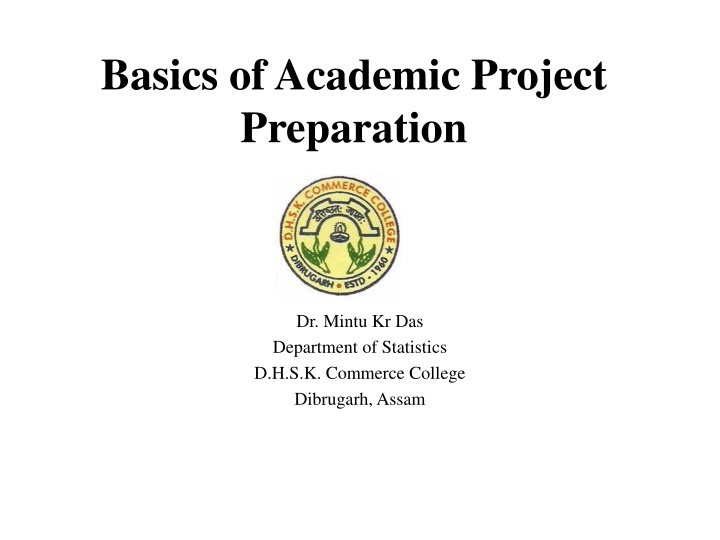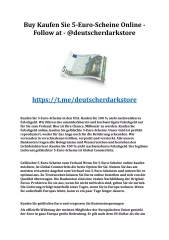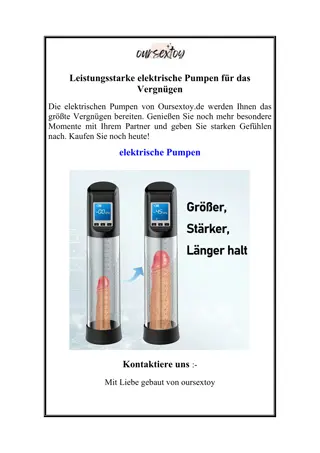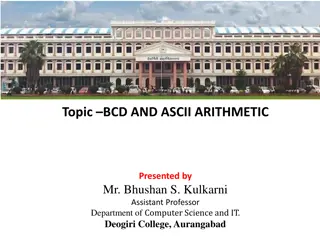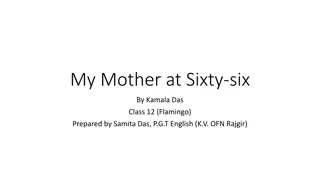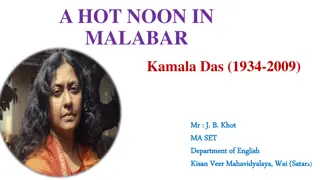Basics of Academic Project Preparation by Dr. Mintu Kr. Das
Understanding the fundamentals of academic project preparation is crucial in research endeavors. Dr. Mintu Kr. Das from the Department of Statistics at D.H.S.K. Commerce College in Dibrugarh, Assam, provides insights on data collection, preliminary concepts, and methods for collecting primary data. Topics covered include the importance of samples, target population, sampling units, types of data, and various data collection methods such as observation, interviews, questionnaires, and more.
Download Presentation

Please find below an Image/Link to download the presentation.
The content on the website is provided AS IS for your information and personal use only. It may not be sold, licensed, or shared on other websites without obtaining consent from the author.If you encounter any issues during the download, it is possible that the publisher has removed the file from their server.
You are allowed to download the files provided on this website for personal or commercial use, subject to the condition that they are used lawfully. All files are the property of their respective owners.
The content on the website is provided AS IS for your information and personal use only. It may not be sold, licensed, or shared on other websites without obtaining consent from the author.
E N D
Presentation Transcript
Basics of Academic Project Preparation Dr. Mintu Kr Das Department of Statistics D.H.S.K. Commerce College Dibrugarh, Assam
Preliminary Concepts Asample is a part of the population. In statistics, a population is a collection/set of similar items or individuals which is of interest for some question or experiments. A sample is a smaller (but hopefully representative) collection of units from a population used to determine truths about that population Why sample? Resources (time, money) and workload Gives results with known accuracy that can be calculated mathematically
Preliminary Concepts Target Population: The population to be studied/ to which the investigator wants to generalize his results. Sampling Unit: smallest unit from which sample can be selected. Sampling scheme :Method of selecting sampling units from sampling frame. The sampling frame is the list all the sampling units from which sample is drawn. Registrar s office. Class registers.
Data Collection The primary data are those which are collected afresh and for the first time, and thus happen to be original in character. The secondary data, on the other hand, are those which have already been collected by someone else and which have already been passed through the statistical process. The researcher would have to decide which sort of data he would be using (thus collecting) for his study and accordingly he will have to select one or the other method of data collection.
Data Collection There are several methods of collecting primary data, particularly in surveys and descriptive researches. Important ones are: (i) observation method, (ii) interview method, (iii) through questionnaires, (iv) through schedules, and (v) other methods which include (a) warranty cards; (b) distributor audits; (c) pantry audits; (d) consumer panels; (e) using mechanical devices; (f) through projective techniques; (g) depth interviews, and (h) content analysis
Data Collection- Observation Method The observation method is the most commonly used method specially in studies relating to behavioural sciences. Here the information is collected by way of investigator s own direct observation without asking from the respondent. The main advantage of this this method is independent of respondents willingness to respond and as such is relatively less demanding of active cooperation on the part of respondents as happens to be the case in the interview or the questionnaire method. This method is particularly suitable in studies which deal with subjects (i.e., respondents) who are not capable of giving verbal reports of their feelings for one reason or the other
Data Collection- Observation Method However, observation method has various limitations. it is an expensive method. the information provided by this method is very limited. sometimes unforeseen factors may interfere with the observational task. At times, the fact that some people are rarely accessible to direct observation creates obstacle for this method to collect data effectively.
Data Collection- Observation Method In case the observation is characterised by a careful definition of the units to be observed, the style of recording the observed information, standardised conditions of observation and the selection of pertinent data of observation, then the observation is structured observation. called as But when observation is to take place without these characteristics to be thought of in advance, the same is termed as unstructured observation.
Data Collection- Observation Method Participant and non-participant types of observation in the context of studies, particularly of social sciences. If the observer observes by making himself, more or less, a member of the group he is observing so that he can experience what the members of the group experience, the observation is called as the participant observation. But when the observer observes as a detached emissary without any attempt on his part to experience through participation what others feel, the observation of this type is often termed as non-participant observation.
Data Collection- Observation Method Controlled and uncontrolled observation. If the observation takes place in the natural setting, it may be termed as uncontrolled observation, but when observation takes place according to definite pre-arranged plans, involving experimental procedure, the same is then termed controlled observation.
Data Collection- Interview Method The interview method of collecting data involves presentation of oral-verbal stimuli and reply in terms of oral-verbal responses. 1. Personal interviews: Personal interview method requires a person known as the interviewer asking questions generally in a face-to-face contact to the other person or persons.
Data Collection- Interview Method The method of collecting information through personal interviews is usually carried out in a structured way. As such we call the interviews as structured interviews. Such interviews involve the use of a set of predetermined questions and of highly standardised techniques of recording. Thus the interviewer in a structured interview follows a rigid procedure laid down, asking questions in a form and order prescribed. As against it, the unstructured interviews are characterised by a flexibility of approach to questioning. Unstructured interviews do not follow a system of pre-determined questions and standardised techniques of recording information.
Data Collection- Interview Method Some of the major advantages of the interview method are as follows: Observation method can as well be applied to recording verbal answers to various questions. The interviewer can usually control which person(s) will answer the questions. This is not possible in mailed questionnaire approach. Samples can be controlled more effectively as there arises no difficulty of the missing returns; non-response generally remains very low. The language of the interview can be adopted to the ability or educational level of the person interviewed and as such misinterpretations concerning questions can be avoided.
Data Collection- Interview Method Some of the weaknesses of the interview method are as follows: Under the interview method the organisation required for selecting, training and supervising the field-staff. It is a very expensive method, specially when large and widely spread geographical sample is taken. There remains the possibility of the bias of interviewer as well as that of the respondent; there also remains the headache of supervision and control of interviewers. Effective interview presupposes proper rapport with respondents that would facilitate free and frank responses. This is often a very difficult requirement.
Data Collection- Interview Method Telephone interviews: This method of collecting information consists in contacting respondents on telephone itself. It is not a very widely used method, but plays important part in industrial surveys, particularly in developed regions. The chief merits of such a system are: It is faster than other methods i.e., a quick way of obtaining information. It is cheaper than personal interviewing method; here the cost per response is relatively low. Representative and wider distribution of sample is possible.
Data Collection- Interview Method Demerits of Telephone interviews Questions have to be short and to the point; verification are difficult. Surveys are restricted to respondents who have telephone facilities. It is not suitable for intensive surveys where comprehensive answers are required to various questions.
Data Collection- THROUGH QUESTIONNAIRES A questionnaire consists of a number of questions printed or typed in a definite order on a form or set of forms. This method of data collection is quite popular, particularly in case of big enquiries. It is being adopted by private individuals, research workers, private and public organisations and even by governments. Here a questionnaire is sent (usually by post) to the persons concerned with a request to answer the questions and return the questionnaire. The respondents have to answer the questions on their own.
Data Collection- THROUGH QUESTIONNAIRES Some of the merits of questionnaire method: There is low cost even when the universe is large and is widely spread geographically. It is free from the bias of the interviewer; answers are in respondents own words. Respondents have adequate time to give well thought out answers. Respondents, who are not easily approachable, can also be reached conveniently.
Data Collection- THROUGH QUESTIONNAIRES Some of the demerits of questionnaire method: Low rate of return of the duly filled in questionnaires; bias due to no-response is often indeterminate. It can be used only when respondents are educated and cooperating. The control over questionnaire may be lost once it is sent. It is difficult to know whether willing respondents are truly representative. This method is likely to be the slowest of all.
Data Collection- THROUGH QUESTIONNAIRES PILOT STUDY OR PILOT SURVEY Before using this method, it is always advisable to conduct pilot study (Pilot Survey) for testing the questionnaires. In a big enquiry the significance of pilot survey is felt very much. Pilot survey is infact the replica and rehearsal of the main survey. Such a survey, being conducted by experts, brings to the light the weaknesses (if any) of the questionnaires and also of the survey techniques. From the experience gained in this way, improvement can be effected.
Data Collection- THROUGH QUESTIONNAIRES Main aspects of a questionnaire: Quite often questionnaire is considered as the heart of a survey operation. Hence it should be very carefully constructed. If it is not properly set up, then the survey is bound to fail. This fact requires us to study the main aspects of a questionnaire viz., the general form, question sequence question and formulation and wording. (in detail....)
Data Collection- THROUGH SCHEDULES This method of data collection is very much like the collection of data through questionnaire, with little difference which lies in the fact that schedules (proforma containing a set of questions) are being filled in by the enumerators who are specially appointed for the purpose. These enumerators along with schedules, go to respondents, put to them the questions from the proforma in the order the questions are listed and record the replies in the space meant for the same in the proforma.
Data Collection- THROUGH SCHEDULES This method requires the selection of enumerators for filling up schedules or assisting respondents to fill up schedules and as such enumerators should be very carefully selected. The enumerators should be trained to perform their job well and the nature and scope of the investigation should be explained to them thoroughly so that they may well understand the implications of different questions put in the schedule. Enumerators should be intelligent and must possess the capacity of crossexamination in order to find out the truth. Above all, they should be honest, sincere, hardworking and should have patience and perseverance.
